Eliot Indian Bible
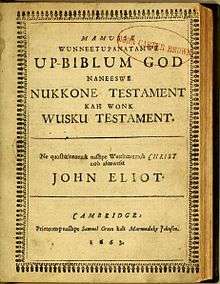 Algonquian Indian Bible title page 1663 | |
| Translator | John Eliot |
|---|---|
| Cover artist | Samuel Green |
| Country | Colonial America |
| Language | Massachusett language |
| Series |
Old Testament New Testament Book of Psalms |
| Subject | Bible |
| Genre | Christian literature |
| Publisher | Samuel Green |
Publication date | 1663 |
| Media type | book |
| Preceded by | New Testament in 1661 |
| x | |

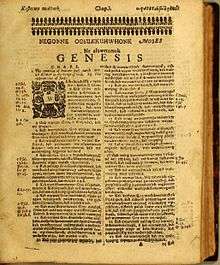
Old Testament first page of 1685 copy
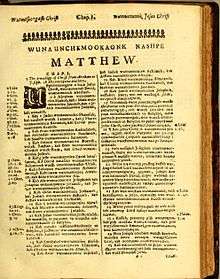
New Testament first page of 1685 copy
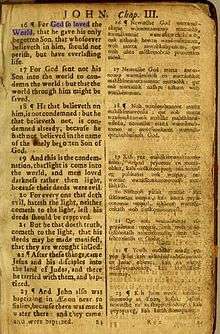
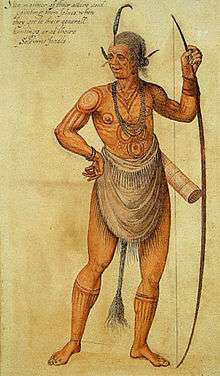
The Eliot Indian Bible (officially: Mamusse Wunneetupanatamwe Up-Biblum God,[1] a.k.a.: Algonquian Bible) was the first Bible published in British North America. English Puritan missionary John Eliot produced a translation of the Geneva Bible into the indigenous Massachusett language.[2] This is the reason that it is also known as Eliot's Indian Bible.[3][4] Mamusse Wunneetupanatamwe Up Biblum God and the cover page of the translated Bible means The Whole Holy His-Bible God, both Old Testament and also New Testament. This turned by the-servant-of-Christ, who is called John Eliot.[5]
History
The history of Eliot's Indian Bible involves three historical events that came together to produce the Algonquian Bible.
America's first printing press
Stephen Daye of England contracted Jose Glover, a wealthy minister who disagreed with the religious teachings of the Church of England, to transport a printing press to America in 1638.[6]
Jose Glover died at sea while traveling to America.[6] His widow Elizabeth (Harris) Glover, Stephen Daye, and the press arrived at Cambridge, Massachusetts, where Mrs. Glover opened her print shop with the assistance of Jose's worker Day.[6] Day started the operations of the first American print shop, which was the forerunner of Harvard University Press.[6] The press was located in the house of the president of Harvard College where religious materials were published in the 1640s, such as the Bay Psalm Book.[7] Elizabeth Glover married president of Harvard College Henry Dunster on June 21, 1641.[6] In 1659, the printing operations were relocated to the Indian College at Harvard when a new printing press was obtained. From the Indian College, Eliot's Indian Bible was printed.[8]
Act of Parliament
In 1649, Parliament enacted An Act for the Promoting and Propagating the Gospel of Jesus Christ in New England,[9] which set up a Corporation in England consisting of a President, a Treasurer, and fourteen people to help them.[10] The name of the Corporation was "The President and Society for the propagation of the Gospel in New England,"[10] but it was later known simply as the New England Company.[11] The Corporation had the power to collect money in England for missionary purposes in New England.[10] This money was received by the Commissioners of the United Colonies of New England and dispersed for missionary purposes such as Eliot's Indian Bible.[10][12]
Arrival of John Eliot
Eliot came to the Massachusetts Bay Colony from England in 1631.[7] One of his duties was to convert the indigenous Massachusett to Christianity.[4][13] Eliot's instrument to do this was through the Christian scriptures.[4] Eliot's feelings were that the Indians felt more comfortable hearing the scriptures in their own language than in English (a language they little understood).[4] Eliot thought it best to translate the English Christian Bible to an Algonquian Bible rather than teach the Massachusett Indians English.[4] He then went about learning the Algonquian Indian language of the Massachusett people so he could translate English to the Natick dialect of the Massachusett language.[4] Eliot translated the entire 66 books of the English Bible in a little over fourteen years.[4][14] It had taken 44 scholars seven years to produce the King James Version of the Christian Bible in 1611.[4] Eliot had to become a grammarian and lexicographer to devise an Algonquian dictionary and book of grammar.[4] He used the assistance of a few local Massachusett Indians in order to facilitate the translation, including Cockenoe, John Sassamon and James Printer.[4][15]
Eliot made his first text for the Corporation for the propagation of the Gospel in New England into the Massachusett language as a one volume textbook primer catechism in 1653 printed by Samuel Green.[16] He then translated and had printed in 1655-56 the Gospel of Matthew, book of Genesis, and Psalms into the Algonquian Indian language.[17][14] It was printed as a sample run for the London Corporation to show what a complete finished Algonquian Bible might look like.[18] The Corporation approved the sample and sent a professional printer, Marmaduke Johnson, to America in 1660 with 100 reams of paper and eighty pounds of new type for the printer involved to print the Bible.[4][19] To accommodate the transcription of the Algonquian Indian language phonemes extra "O's" and "K's" had to be ordered for the printing press.[4]
Johnson had a three-year contract to help assist to print the entire Bible of 66 books (Old Testament and New Testament).[18] Eliot’s Indian Bible was printed in Cambridge, Massachusetts, at Harvard College by Samuel Green.[7] In 1661, with the assistance of the English printer Johnson and a Nipmuc named James Printer, Green printed 1500 copies of the New Testament.[4][7] In 1663 they printed 1000 copies of the complete Bible of all 66 books (Old Testament and New Testament) in a 1,180 page volume.[3][4][20] The costs for this production was paid by the Corporation, authorized by the Parliament of England by donations collected in England and Wales.[18]
Description
Eliot was determined to give the Christian Bible to them in their own Massachusett language.[21] He learned the Natick dialect of the Massachusett language and its grammar.[21] The dialect "Natick" name came from a town at Roxbury that was close to Boston where Eliot lived amongst the Massachusett Indians as their pastor for 57 years.[8] He converted these local Natick Indians to Christianity.[21] By 1674 there were 1400 Massachusett Christians.[8]
Eliot worked on the Indian Bible for over fourteen years before publication. [22] England contributed about 16,000 pounds for its production by 1660.[23] The money came from private donations in England and Wales.[23] There was no donations or money from the New England colonies for Eliot's Indian Bible.[23] The translation answered the question received many times by Eliot from the Massachusett was "How may I get faith in Christ?"[23] The ecclesiastical answer was "Pray and read the Bible."[23] After Eliot's translation, there was a Bible they could read.[23]
The title page of the Algonquian Indian Bible was done in the Natick dialect of the Massachusett Indian language as was the complete Christian Bible of the Old and New Testament. Eliot’s Indian Bible is noteworthy because it demonstrated the passion of early colonists to provide the local American Indians with the scriptures. The Massachusetts general court wanted the diffusion of Christianity done with all diligence.[8]
Eliot translated the Bible from an unwritten American Indian language into a written alphabet that the Algonquian Indians could read and understand.[23] He was the only missionary to make a new alphabet from an unwritten language for purposes of teaching scriptures, in over a thousand years since Ulfilas constructed the Gothic alphabet.[23] To show the difficulty of the Algonquian language used in Eliot's Indian Bible, Cotton Mather gives as an example the Algonquian word Nummatchekodtantamoonganunnonash (32 characters) which means "our lusts".[3] He said that the Indian language did not have the least affinity to or derivation from any European speech.[3]
Some ecclesiastical questions given to Eliot by the Natick Indians that were to be answered by the new Algonquian Bible and Indian religious learning were:
- If but one parent believe, what state are our children in?
- How doth much sinne make grace abound?
- If an old man as I repent, may I be saved?
- What meaneth that, Let the trees of the Wood rejoice?
- What meaneth that, We cannot serve two masters?
- Can they in Heaven see us here on Earth?
- Do they see and know each other? Shall I know you in heaven?
- Do they know each other in Hell?
- What meaneth God, when he says, Ye shall be my Jewels
- If God made hell in one of the six dayes, why did God make Hell before Adam had sinned?
- Doe not Englishmen spoile their souls, to say a thing cost them more then it did? and is it not all one as to steale?[24]
Legacy
In 1664 a specially constructed unique display copy was given to King Charles II by Robert Boyle, the Governor of the 'Corporation' for the propagation of the Gospel in New England.[25] Many copies of the first edition (1663) of Eliot’s Indian Bible were destroyed by the British in 1675-76 by a war against Metacomet (war chief of the Wampanoag Indians).[20][26] In 1685, after some debate, the 'Corporation' decided to publish another edition of Eliot’s Indian Bible. [27] The second edition of the entire Bible was finished in 1686 at a fraction of the cost of what it took to put out the first edition.[28] There were 2000 copies printed.[20] A dedication to Robert Boyle, governor of Massachusetts, had a special single leaf printed and placed into the 1685 presentation copies sent to Europe.[29]
The first English edition of the entire Bible was not published in the United States for some 120 years after Eliot's Indian Bible when Robert Aitken's Bible came out in 1782.[30] Eliot's Indian Bible translation of the complete Christian Bible was supposedly written with one pen.[31] Eliot's Indian Bible printing project was the largest printing job done in 17th-century Colonial America.[11]
The Massachusett Indian language Natick dialect that the translation of Eliot's Bible was made in no longer is used in the United States.[31] The Algonquin Bible is today unreadable by most people in the world.[3] Eliot's Indian Bible is notable for being the earliest known example of the translation and putting to print the entire 66 books of the Christian Bible into a new language of no previous written words.[13] Eliot's Indian Bible was also significant because it was the first time the entire Bible was translated into a language not native to the translator. Previously, scholars had translated the Bible from Greek, Hebrew, or Latin into their own language. With Eliot, the translation was into a language he was just learning for the purpose of evangelization.[3]
In 1709 a special edition of the Algonquin Bible was authored by Experience Mayhew with the Indian words in one column and the English words in the opposite column.[32] It had only Psalms and the Gospel of John.[32] It was used for training the local Massachusett Indians to read the scriptures.[32] This Algonquin Bible was a derivative of Eliot's Indian Bible.[33] The 1709 Algonquin Bible text book is also referred to as The Massachuset psalter.[32] This 1709 edition is based on the Geneva Bible, like Eliot's Indian Bible (aka: Mamusse Wunneetupanatamwe Up Biblum God).[2]
A second edition printing of Eliot's Indian Bible was an instrumental source for the Wôpanâak Language Reclamation Project, where it was compared to the King James Bible in order to relearn Wôpanâak (Wampanoag) vocabulary and grammar.[34]
See also
References
- ↑ Szasz 2007, p. 114.
- 1 2 Mayhew 2008, p. 64.
- 1 2 3 4 5 6 "The Eliot Indian Bible: First Bible Printed in America". Library of Congress Bible Collection. Library of Congress. 2012. Archived from the original on 26 May 2013. Retrieved 19 August 2013.
- 1 2 3 4 5 6 7 8 9 10 11 12 13 14 Thorowgood 2003, p. 13.
- ↑ Eliot, John. Encyclopædia Britannica. 1911. p. chapter 9.2 (Elias Levita — Elizabeth).
- 1 2 3 4 5 "Stephen Day". Britannica.com. Encyclopædia Britannica. 2013. Retrieved 19 August 2013.
- 1 2 3 4 "Printing And The Indian Bible". Early Native American Resources in the Harvard University Archives. Harvard University. 2010. Retrieved 19 August 2013.
- 1 2 3 4 Arnold 2008, p. 68.
- ↑ "John Eliot's Indian Bible. Cambridge, 1663, 1665, 1685". University of California - Berkeley. 2012. Retrieved 19 August 2013.
- 1 2 3 4 "An Act for the promoting and propagating the Gospel of Jesus Christ in New England". British History Online. University of London & History of Parliament Trust. 2013. Retrieved 19 August 2013.
- 1 2 Nord 2004, p. 20.
- ↑ Thomas 1874, p. 67.
- 1 2 Rumball-Petre 2000, p. 8.
- 1 2 Baker 2002, p. 180.
- ↑ Rumball-Petre 2000, p. 14.
- ↑ Round 2010, p. 26.
- ↑ Gregerson 2013, p. 73.
- 1 2 3 Winship 1946, p. 208-244.
- ↑ "The Eliot Indian Bible: First Bible Printed in America". MyLOC. Library of Congress. 2013. Archived from the original on 30 April 2013. Retrieved 19 August 2013.
- 1 2 3 Deane, Charles (January 1, 1873). May Meeting, 1874. Letter of S. Danforth; Eliot's Indian Bible; Jasper Danckaerts; Dankers's Journal. Proceedings of the Massachusetts Historical Society. p. 308. Retrieved 19 August 2013.
- 1 2 3 American Indian 1974, p. 1111.
- ↑ Francis 1836, p. 235.
- 1 2 3 4 5 6 7 8 Klauber 2008, p. 28.
- ↑ Baker 2002, p. 180-191.
- ↑ Massachusetts Historical Society 1862, p. 376.
- ↑ Stone 2010, p. 82.
- ↑ Thorowgood 2003, p. 14.
- ↑ Beach 1877, p. 411.
- ↑ Eliot, John, 1604-1690; Cotton, John, 1640-1699; Company for Propagation of the Gospel in New England and Parts Adjacent in America (1685). "Mamusse wunneetupanatamwe Up-Biblum God naneeswe Nukkone Testament kah wonk Wusku Testament. (1685)". Internet Archive. Cambridge, Massachusetts: Printer - Samuel Green. Retrieved 19 August 2013.
- ↑ "First complete Bible printed in America". American Treasures Gallery Treasures. Library of Congress. July 27, 2010. Retrieved 19 August 2013.
- 1 2 U.S. Government Printing Office 1898, p. 14.
- 1 2 3 4 "The Massachuset psalter: or, Psalms of David with the Gospel according to John, in columns of Indian and English: Being an introduction for training up the aboriginal natives, in reading and understanding the Holy Scriptures (1709)". Internet Archive. Boston: Printed by B. Green, and J. Printer, for the Honourable Company for the Propagation of the Gospel in New-England. 1709. Retrieved 19 August 2013.
- ↑ Mayhew, Experience, 1673-1758 + Eliot, John, 1604-1690 (1709). "The Massachuset psalter or, Psalms of David with the Gospel according to John, in columns of Indian and English. [microform] : Being an introduction for training up the aboriginal natives, in reading and understanding the Holy Scriptures". Boston, N.E. : Printed by B. Green, and J. Printer, for the Honourable Company for the Propagation of the Gospel in New-England. Retrieved 19 August 2013.
- ↑ Mifflin, Jeffrey (April 22, 2008). "Saving a Language". MIT Technology Review. Retrieved 2016-10-28.
Bibliography
- American Indian, Culture and Research Journal (1974). American Indian Culture and Research Journal. American Indian Culture and Research Center, University of California.
- Arnold, Clinton E. (2008). How We Got the Bible: A Visual Journey. Zondervan. ISBN 978-0-310-25306-8.
- Baker, David J. (2002). British Identities and English Renaissance Literature. Cambridge University Press. ISBN 978-0-521-78200-5.
- Beach, William Wallace (1877). The Indian Miscellany: Containing Papers on the History, Antiquities, Arts, Languages, Religions, Traditions and Superstitions of the American Aborigines ; with Descriptions of Their Domestic Life, Manners, Customs, Traits, Amusements and Exploits ; Travels and Adventures in the Indian Country ; Incidents to Border Warfare; Missionary Relations, Etc. J. Munsell.
- Francis, Convers (1836). Life of John Eliot, the Apostle to the Indians. Hilliard, Gray.
- Gregerson, Linda (10 April 2013). Empires of God: Religious Encounters in the Early Modern Atlantic. University of Pennsylvania Press. ISBN 978-0-8122-2260-9.
- Klauber, Martin I. (1 April 2008). The Great Commission: Evangelicals and the History of World Missions. B&H Publishing Group. ISBN 978-0-8054-4300-4.
- Massachusetts Historical Society (1862). Proceedings of the Massachusetts Historical Society. The Society.
- Mayhew, Experience (2008). Experience Mayhew's Indian Converts: A Cultural Edition. Univ of Massachusetts Press. ISBN 978-1-55849-661-3.
- Nord, David Paul (23 July 2004). Faith in Reading : Religious Publishing and the Birth of Mass Media in America: Religious Publishing and the Birth of Mass Media in America. Oxford University Press. ISBN 978-0-19-803861-0.
- Round, Phillip H. (11 October 2010). Removable Type: Histories of the Book in Indian Country, 1663-1880. Univ of North Carolina Press. ISBN 978-0-8078-9947-2.
- Rumball-Petre, Edwin A. R. (2000). America's First Bibles: With a Census of 555 Extant Bibles. Martino Publishing. ISBN 978-1-57898-260-8.
- Stone, Larry (21 September 2010). The Story of the Bible: The Fascinating History of Its Writing, Translation & Effect on Civilization. Thomas Nelson Inc. ISBN 978-1-59555-119-1.
- Szasz, Margaret (2007). Indian Education in the American Colonies, 1607-1783. University of Nebraska Press. ISBN 978-0-8032-5966-9.
- Thomas, Isaiah (1874). The History of Printing in America: With a Biography of Printers, and an Account of Newspapers. To which is Prefixed a Concise View of the Discovery and Progress of the Art in Other Parts of the World. In Two Volumes. From the Press of Isaiah Thomas, jun. Isaac Sturtevant, Printer.
- Thorowgood, Thomas (2003). The Eliot Tracts: With Letters from John Eliot to Thomas Thorowgood and Richard Baxter. Greenwood Publishing Group. ISBN 978-0-313-30488-0.
- U.S. Government Printing Office (1898). Congressional Edition. U.S. Government Printing Office.
- Winship, George Parker (1946). The Cambridge Press, 1638-1692: A Reëxamination of the Evidence Concerning the Bay Psalm Book and the Eliot Indian Bible as Well as Other Contemporary Books and People. University of Pennsylvania Press.
External links
| Wikimedia Commons has media related to Algonquian Bible. |
- Stories of Eliot and the Indians
- Complete Algonquian Indian Bible 1663
- Complete Algonquian Indian Bible 1685
- Education And Harvard's Indian College
- Psalms of David with the Gospel according to John, in columns of Indian and English
- A Sketch of the Life of the Apostle Eliot: Prefatory to a Subscription for Erecting a Monument